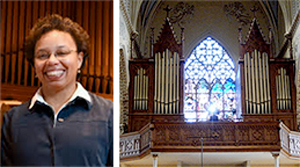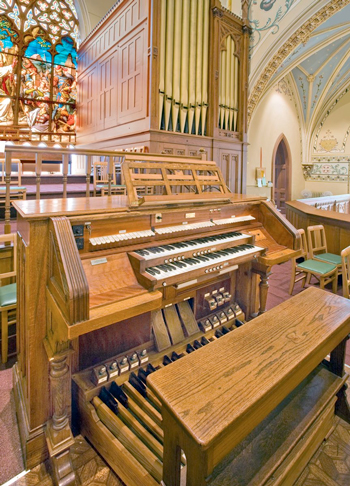by Daniel Hathaway

Oddly enough, nobody seems to know where the Schuelke instrument originally came from, but it replaced an 1891 organ that perished in a tornado in 1909. The Votteler-Holtkamp-Sparling Company used nearly all of Schuelke’s original pipework in a 1933 rebuild. The next renovation was accomplished in the 1980s when parish volunteers replaced leather and wiring. Then after a series repairs by the Holtkamp Company, the instrument was completely restored by the James Leek Company beginning in 2016. Leek added two new stops to the tonal palette — a three-rank mixture and a clarinet.
As Shrine music director David Krakowski told the audience, the quarter-million-dollar 2016-17 restoration was funded by the Kulas, Fred Geis, Corinne Dodero, Third Federal, and Kurz Foundations as well as by “donations from parishioners, candy, cookbook, tomato plant and bakery sales, and monthly raffles.” Clearly, the people at St. Stan’s really wanted this project to happen.
Keller didn’t waste any time demonstrating the full sound of the organ, launching her program with a noble performance of Sigfried Karg-Elert’s Nun danket alle Gott, “Marche Triomphale.” A warm, bass-rich sound enveloped the nave, gently vibrating the wood surfaces, and a noble clang of reed stops colored the sonic mix.
Next, the Schuelke proved to be a sensitive continuo instrument, supporting Gabriel’s and Ross’s lyrical lines in Telemann’s a-minor Trio Sonata with colorful flutes and gentle foundation stops.

The best organ recitals tuck a surprising piece in at just the right moment, and Naji Hakim’s Capriccio for Violin and Organ provided a delightful entremet on Sunday. Hakim, who succeeded Olivier Messiaen at La Trinité in Paris, is known for his improvisations and avant-garde pieces, but the Capriccio is an outlier — a vaudevillian bon-bon that Ross and Keller had great fun with. At times, the organist provided the kind of percussive undercurrent more commonly heard on a theater organ.
And the best recitals also include a rarity, in this case the “Air” from Florence Price’s Suite for Organ, a mildly bluesy piece by the first African-American woman to have a symphony performed — in her case by the Chicago Symphony. Price was also a student of Leo Sowerby, and clearly absorbed some of her mentor’s complex harmonies.
Felix Mendelssohn’s Fourth Sonata closed the program with a work that suited the instrument perfectly. The lovely clarinet stop made an appearance in the Andante, and the new mixture melded beautifully into the plenum in the finale. Keller, who also serves as associate organist at Trinity Cathedral, played the Mendelssohn with expansive gestures and fluent technique, giving a nod to the composer’s moments of Victorian sentimentality, but also bringing out the strong rhetorical gestures and structure of his music.
Published on ClevelandClassical.com October 24, 2017.
Click here for a printable copy of this article



